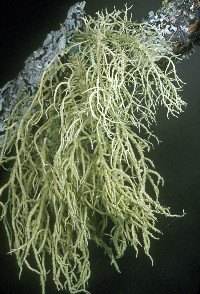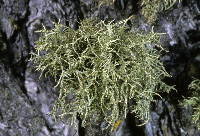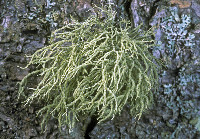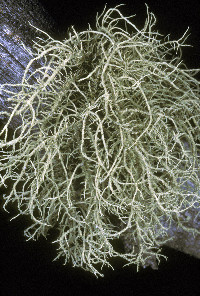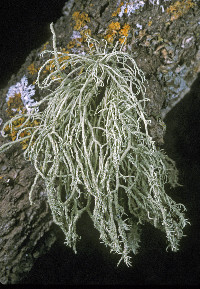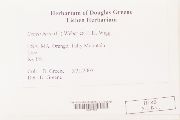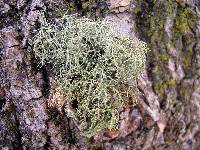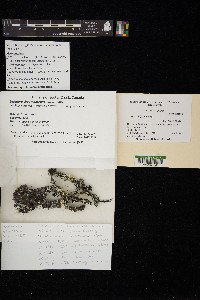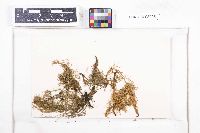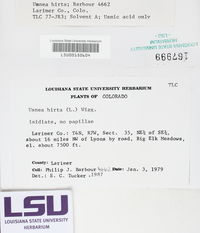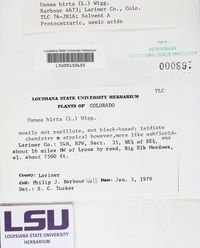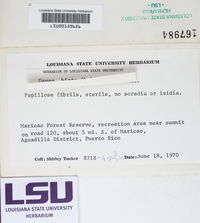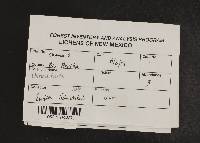
Consortium of Lichen Herbaria
- building a Global Consortium of Bryophytes and Lichens as keystones of cryptobiotic communities -
- Home
- Search
- Images
- Species Checklists
- US States: O-Z >
- US National Parks
- Central America
- South America
- US National Parks
- Southern Subpolar Region
|
|
|
|
Family: Parmeliaceae
[Lichen hirtus L., moreUsnea barbata var. villosa (Ach.) Koltz, Usnea florida f. minutissima Mereschk., Usnea florida f. villosa (Ach.) Zahlbr., Usnea florida var. hirta (L.) Ach., Usnea florida var. villosa Ach., Usnea hirta f. minutissima (Mereschk.) Erichsen, Usnea hirta subsp. comiformis (Motyka ex Räsänen) Motyka, Usnea hirta subsp. hirta (L.) Weber ex F.H. Wigg., Usnea hirta subsp. villosa (Ach.) Räsänen, Usnea hirta var. comiformis Motyka ex Räsänen, Usnea hirta var. minutissima (Mereschk.) Cretz., Usnea plicata var. hirta (L.) Ach., Usnea variolosa Motyka] |
Nash, T.H., Ryan, B.D., Gries, C., Bungartz, F., (eds.) 2007. Lichen Flora of the Greater Sonoran Desert Region. Vol 3. Thallus: shrubby, usually short, up to 5 cm long, rarely longer and subpendant (up to 13 cm), flaccid to stiff branching: anisotomic-dichotomous, divergent basal part: concolorous to the branches to pale branches: main branches irregular, distinctly segmented, ±swollen, lateral branches not narrowed at point of attachment segments: terete to strongly ridged, cylindrical to ±sausage-like; transversal furrows: numerous, on main branches papillae: absent (can be mistaken with young fibrils) tubercles: absent fibercles: nearly absent to numerous, looking like pseudocyphellae fibrils: young fibrils (0.1-0.5 mm) nearly absent to numerous, covering densely the branches, mature fibrils (1-2 mm) nearly absent to numerous and giving a fish-bone like appearance to the branches soralia: few to numerous, usually developing on fibercles, punctiform, smaller than half the diameter of the branches isidiomorphs: absent (can be mistaken for young fibrils) cortex: thin to thick (3-14%), dull to distinctly shiny, never cracked medulla: lax, dense or compact, not pigmented axis: thin to wide Apothecia: rare, small, 1-3 mm in diam., subterminal Spot tests: medulla K-, C-, KC- P-, or K+ yellow turning slowly orange, C-, KC- P+yellow Secondary metabolites: either none detected or norstictic acid ±fatty acids (murolic group) or fatty acids alone (murolic group). Substrate and ecology: on bark and dead trees or wood, very rarely on rock, in the mountains between 650 and 3600 m World distribution: probably cosmopolitan on every continent Sonoran distribution: mountains of Arizona, southern California, Baja California and Sinaloa. Note: Two subspecies of U. hirta are recognized, one widely distributed and one restricted to Baja California. Intermediate specimens occur in the area of overlap. Nash, T.H., Ryan, B.D., Gries, C., Bungartz, F., (eds.) 2007. Lichen Flora of the Greater Sonoran Desert Region. Vol 3. Thallus: usually flaccid cortex: thin (3-7%) dull to ±shiny medulla: lax, rarely dense. Substrate and ecology: inland on bark (on Pinus spp., Quercus spp., Pseudostsuga menziesii, Abies spp., Picea spp., etc.) or on wood, very rarely on rock, mainly in mixed conifer-oak forests, ponderosa pine forests, spruce-fir communities, oak-juniper woodlands, between 650 and 3600 m World distribution: probably cosmopolitan on every continent Sonoran distribution: a frequent inland taxon in the mountains of Arizona, the Sierra Madre Occidental of Chihuahua, and northern Baja California, rarely in southern California and Baja California (Isla Cedros) near the ocean at low altitudes. |
|
|
|
Powered by Symbiota



